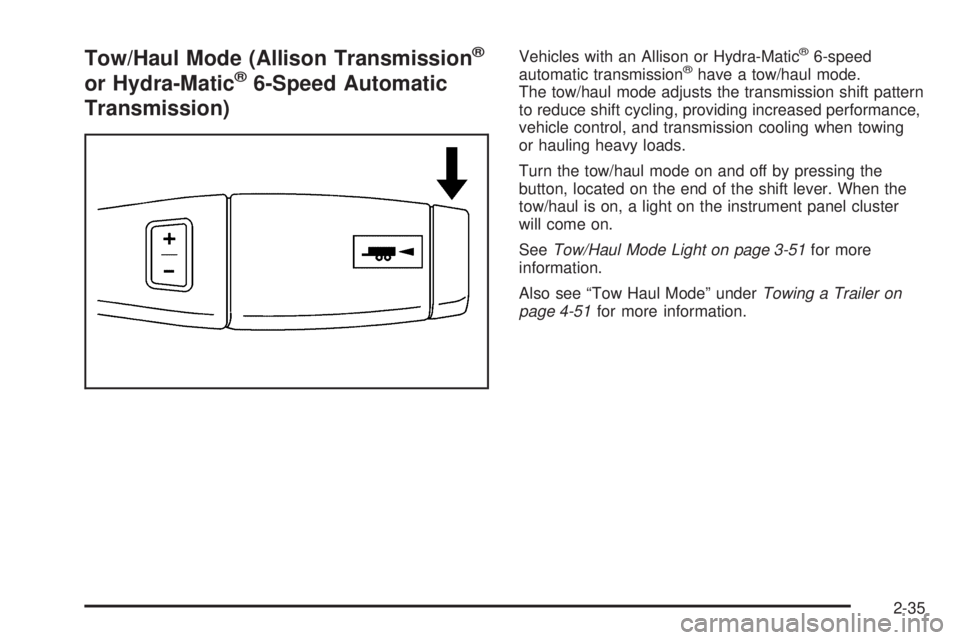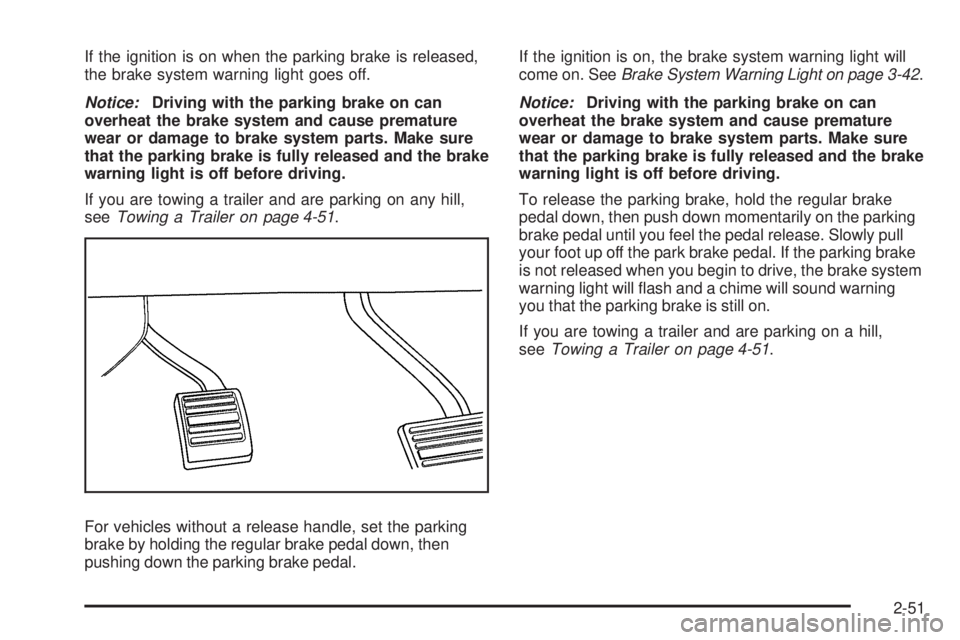2009 GMC SIERRA towing
[x] Cancel search: towingPage 133 of 596

Tow/Haul Mode (Allison Transmission®
or Hydra-Matic®6-Speed Automatic
Transmission)
Vehicles with an Allison or Hydra-Matic®6-speed
automatic transmission®have a tow/haul mode.
The tow/haul mode adjusts the transmission shift pattern
to reduce shift cycling, providing increased performance,
vehicle control, and transmission cooling when towing
or hauling heavy loads.
Turn the tow/haul mode on and off by pressing the
button, located on the end of the shift lever. When the
tow/haul is on, a light on the instrument panel cluster
will come on.
SeeTow/Haul Mode Light on page 3-51for more
information.
Also see “Tow Haul Mode” underTowing a Trailer on
page 4-51for more information.
2-35
Page 134 of 596

Grade Braking (Allison Transmission®
or Hydra-Matic®6-Speed Automatic
Transmission)
The Grade Braking shift modes can be activated by
pressing the button on the end of the shift control lever.
While in Range Selection Mode, Grade Braking is
deactivated allowing the driver to select a desired
range of gears.
Grade Braking is only active while the Tow/Haul Mode is
selected and you are not in the Range Selection Mode.
See “Tow/Haul Mode listed previously andAutomatic
Transmission Operation on page 2-28for more
information on the Range Selection Mode. Grade Braking
assists in maintaining desired vehicle speeds when
driving on downhill grades by automatically implementing
a shift schedule that utilizes the engine and transmission
to slow the vehicle. This reduces wear on the braking
system and increases control of the vehicle. Grade
Braking monitors vehicle speed, acceleration, engine
torque and brake pedal usage. Using this information,
it detects when the truck is on a downhill grade and the
driver desires to slow the vehicle by pressing the brake.
Also seeTowing a Trailer on page 4-51for more
information.
Cruise Grade Braking (Allison
Transmission®or Hydra-Matic®
6-Speed Automatic Transmission)
Cruise Grade Braking assists when driving on a
downhill grade. It maintains vehicle speed by
automatically implementing a shift schedule that
uses the engine and the transmission to slow the
vehicle. Cruise Grade Braking operates while Cruise
Control is engaged in Tow/Haul mode to assist in
maintaining vehicle speed under loaded vehicle
conditions. It utilizes vehicle acceleration and deviation
from desired speed to determine the correct gear for the
operating condition. If vehicle speed is above the desired
speed the transmission will downshift to slow the vehicle.
If vehicle speed is near or below desired speed the trans
will upshift, allowing vehicle speed to increase.
While in the Range Select Mode (RSM) mode, cruise
grade braking is not available.
SeeAutomatic Transmission Operation on page 2-28.
2-36
Page 136 of 596

Some delay between shifting and when the indicator
light comes on is normal.
Recommended Transfer Case Settings
Driving ConditionsTransfer Case Settings
2m4m4nN
Normal YES
Severe YES
Extreme YES
Vehicle in Tow* YES
*SeeRecreational Vehicle Towing on page 4-45
Towing Your Vehicle on page 4-45
Notice:Driving on clean, dry pavement in
four-wheel drive for an extended period of time can
cause premature wear on the vehicle’s powertrain.
Do not drive on clean, dry pavement in Four-Wheel
Drive for extended periods of time.
4
n(Four-Wheel-Drive Low):This setting also engages
the front axle and delivers extra torque. You may never
need Four-Wheel-Drive Low. It sends maximum power to
all four wheels. You might choose Four-Wheel-Drive Low
if you are driving off-road in deep sand, deep mud, deep
snow, and while climbing or descending steep hills.If the vehicle has StabiliTrak
®, shifting into
Four-Wheel-Drive Low will turn Traction Control and
StabiliTrak
®off. SeeStabiliTrak®System on page 4-6.
A parking brake symbol
is located next to the
N (Neutral) symbol as a
reminder to set the parking
brake before shifting the
transfer case into
N (Neutral).
{CAUTION:
Shifting the transfer case to Neutral can cause
the vehicle to roll even if the transmission is in
P (Park). You or someone else could be seriously
injured. Be sure to set the parking brake before
placing the transfer case in Neutral. SeeParking
Brake on page 2-50.
2-38
Page 137 of 596

N (Neutral):Shift to this setting only when the vehicle
needs to be towed. SeeRecreational Vehicle Towing
on page 4-45orTowing Your Vehicle on page 4-45.
2
m(Two-Wheel-Drive High):This setting is used for
driving in most street and highway situations. The front
axle is not engaged in two-wheel drive. This setting also
provides the best fuel economy.
4
m(Four-Wheel-Drive High):Use this setting when
you need extra traction, such as on snowy or icy roads
or in most off-road situations. This setting also engages
the front axle to help drive your vehicle. This is the best
setting to use when plowing snow.
You can shift from Two-Wheel-Drive High to
Four-Wheel-Drive High or Four-Wheel-Drive High to
Two-Wheel-Drive High while the vehicle is moving.
In extremely cold weather, it may be necessary to stop
or slow the vehicle to shift into Four-Wheel-Drive High.
When Using the Manual Transfer Case
Shifting should be made using quick motions.
Shifting slowly may make it more difficult to shift.
You may notice that it is harder to shift when the
vehicle is cold. After the vehicle warms up the
shifting will return to normal.
While in Four-Wheel High or Four-Wheel-Drive Low
you may experience reduced fuel economy.
Avoid driving in Four-Wheel Drive on clean, dry
pavement. It may cause your tires to wear faster,
make the transfer case harder to shift, and run
noisier.
If the transfer case shifter is in the N (Neutral)
position and you have difficulty reaching the selected
transfer case mode, with the engine running, shift the
transmission momentarily to drive and then back to
N (Neutral). This will realign the gear teeth in the
transfer case and allow you to complete the shift.
2-39
Page 139 of 596

Shifting In or Out of Neutral
1. With the vehicle running and the engine at an idle
set the parking brake.
2. Place the transmission into N (Neutral).
Shift the transfer case in one continuous motion into or
out of the N (Neutral) position.
Electronic Transfer Case
The transfer case knob is
located next to the
steering column.
Use the dial to shift into and out of four-wheel drive.
Recommended Transfer Case Settings
Driving ConditionsTransfer Case Settings
2m4m4nN
Normal YES
Severe YES
Extreme YES
Vehicle in Tow* YES
*SeeRecreational Vehicle Towing on page 4-45
Towing Your Vehicle on page 4-45
You can choose among four driving settings:
Indicator lights in the dial show which setting you are in.
The indicator lights will come on brie�y when you turn on
the ignition and one will stay on. If the lights do not come
on, you should take the vehicle to your dealer/retailer
for service. An indicator light �ashes while shifting the
transfer case and remains illuminated when the shift is
complete. If for some reason the transfer case cannot
make a requested shift, it will return to the last chosen
setting.
2-41
Page 140 of 596

2m(Two-Wheel-Drive High):This setting is used for
driving in most street and highway situations. The front
axle is not engaged in Two-Wheel Drive. This setting also
provides the best fuel economy.
4
m(Four-Wheel-Drive High):Use the
Four-Wheel-Drive High position when extra
traction is needed, such as on snowy or icy roads
or in most off-road situations. This setting also engages
the front axle to help drive the vehicle. This is the best
setting to use when plowing snow.
4
n(Four-Wheel-Drive Low):This setting also engages
the front axle and delivers extra torque. You may never
need this setting. It sends maximum power to all four
wheels. You might choose Four-Wheel-Drive Low while
driving off-road in deep sand, deep mud, deep snow, and
while climbing or descending steep hills.
If the vehicle has StabiliTrak
®, shifting into
Four-Wheel-Drive Low will turn Traction Control and
StabiliTrak
®off. SeeStabiliTrak®System on page 4-6.
{CAUTION:
Shifting the transfer case to N (Neutral) can
cause the vehicle to roll even if the transmission
is in P (Park). You or someone else could be
seriously injured. Be sure to set the parking brake
before placing the transfer case in N (Neutral).
SeeParking Brake on page 2-50.
N (Neutral):Shift the vehicle’s transfer case
to N (Neutral) only when towing the vehicle.
SeeRecreational Vehicle Towing on page 4-45or
Towing Your Vehicle on page 4-45for more information.
If the SERVICE 4–Wheel Drive message stays on,
you should take the vehicle to your dealer/retailer
for service. See “Service 4–Wheel Drive message”
underDIC Warnings and Messages on page 3-66.
2-42
Page 145 of 596

If the vehicle has StabiliTrak®, shifting into
Four-Wheel-Drive Low will turn Traction Control and
StabiliTrak
®off. SeeStabiliTrak®System on page 4-6.
{CAUTION:
Shifting the transfer case to N (Neutral) can
cause the vehicle to roll even if the transmission
is in P (Park). You or someone else could be
seriously injured. Be sure to set the parking brake
before placing the transfer case in N (Neutral).
SeeParking Brake on page 2-50.
N (Neutral):Shift the vehicle’s transfer case
to N (Neutral) only when towing the vehicle. See
Recreational Vehicle Towing on page 4-45orTowing
Your Vehicle on page 4-45for more information.If the SERVICE 4-Wheel Drive message stays on,
you should take the vehicle to your dealer/retailer
for service. See “Service 4-Wheel Drive message”
underDIC Warnings and Messages on page 3-66.
Shifting Into Four-Wheel-Drive High
or AUTO (Automatic Four-Wheel Drive)
Turn the knob to the Four-Wheel-Drive High or AUTO
position. This can be done at any speed, except when
shifting from Four-Wheel-Drive Low. The indicator light
will �ash while shifting. It will remain on when the shift is
completed.
Shifting Into Two-Wheel-Drive High
Turn the knob to the Two-Wheel-Drive High position.
This can be done at any speed, except when shifting
from Four-Wheel-Drive Low. The indicator light will
�ash while shifting. It will remain on when the shift
is completed.
2-47
Page 149 of 596

If the ignition is on when the parking brake is released,
the brake system warning light goes off.
Notice:Driving with the parking brake on can
overheat the brake system and cause premature
wear or damage to brake system parts. Make sure
that the parking brake is fully released and the brake
warning light is off before driving.
If you are towing a trailer and are parking on any hill,
seeTowing a Trailer on page 4-51.
For vehicles without a release handle, set the parking
brake by holding the regular brake pedal down, then
pushing down the parking brake pedal.If the ignition is on, the brake system warning light will
come on. SeeBrake System Warning Light on page 3-42.
Notice:Driving with the parking brake on can
overheat the brake system and cause premature
wear or damage to brake system parts. Make sure
that the parking brake is fully released and the brake
warning light is off before driving.
To release the parking brake, hold the regular brake
pedal down, then push down momentarily on the parking
brake pedal until you feel the pedal release. Slowly pull
your foot up off the park brake pedal. If the parking brake
is not released when you begin to drive, the brake system
warning light will �ash and a chime will sound warning
you that the parking brake is still on.
If you are towing a trailer and are parking on a hill,
seeTowing a Trailer on page 4-51.
2-51